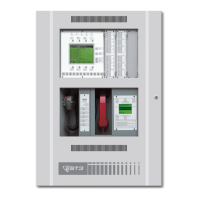Installation
EST3 Installation and Service Manual
5.50
Connecting a CDR-3 Zone Coder for coded tone output
The CDR-3 Zone coder can be connected to the 3-ASU’s AUX
input to provide a coded or march time tone to the audio system.
Refer to Figure 5-11. If you’re connecting a CDR-3 to a serial
port that is shared with a PT-1S printer, you must connect both
devices using an IOP3A, as shown in the wiring diagram in this
topic.
What you will need
An initial startup version of the project database that contains a
switch programmed to turn the amplifiers onto the Auxiliary
channel. See “Creating an initial startup version of the project
database.”
An RMS voltmeter (Fluke 83 or equivalent)
Adjusting the gain on the 3-ASU auxiliary input
The 3-ASU auxiliary input gain adjustment is critical to the
operation of this application. Before adjusting the 3-ASU, set
each zoned amplifier module in the cabinet for their configured
RMS output level. See “Adjusting amplifier output levels.”
To adjust the gain on the 3-ASU auxiliary input
1. Connect the coded tone output on the CDR-3 directly to the
3-ASU auxiliary input by bypassing the duration relay.
2. Set the 3-ASU auxiliary input gain pot to the mid-range
position.
3. Determine which zoned amplifier module requires the
highest gain adjustment (the module whose gain adjustment
pot is turned the most counter-clockwise). Use this amplifier
as the worst-case amplifier.
4. Disconnect the field wiring from all the amplifiers in the
cabinet except for the worst-case amplifier. This is to
prevent the CDR-3’s supervisory tone from being broadcast
throughout the premises.
5. Place an RMS meter across the worst-case amplifier’s TB2
NAC/B+ and NAC/B- terminals.
6. Press the AUX_INPUT_ADJ switch. This places the coder’s
supervisory tone onto the Auxiliary channel. The
supervisory tone occurs approximately every 5 seconds.
7. Adjust the 3-ASU’s auxiliary input gain pot until the RMS
meter displays the amplifier’s configured output level (22-28

